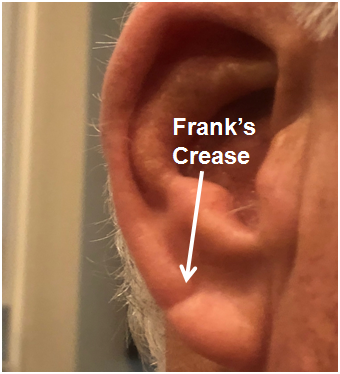How To Get Rid Of Earlobe Creases

Do you have one thick ear lobe? Or two?
If you only have one thick ear lobe:
Thick ear lobes (if only one side is thick) can be caused by infection. Is the ear lobe red or warm to the touch or tender? If so, see your health care provider. Allergies to metals in ear jewelry can also cause inflammation of the ear lobes, typically (but not always) on both sides.
thick ear lobes can be a red flag:

While cholesterol and fats are being deposited in the inner lining of the arteries, they can also be deposited in the ear lobes, making them thicker.
Do you have thick ear lobes?
One of our patients said, "Those ear lobes saved my life." After hearing his ear lobes might be a red flag for heart disease, he got tested. He had more artery disease than 99% of guys his age. Now his arteries (and his ear lobes) are getting better. Click the "Reversing Heart Disease" video to hear his story. You can see his artery trending report here.
Do you have a diagonal crease in your ear lobes? (Frank's sign)

Eventually, thick ear lobes develop a diagonal crease, called "Frank's crease" or "Frank's sign (1)." By the time Frank's sign appears, there is a strong association with heart disease. One study (2) found that 78% of people with Frank's ear lobe crease have heart disease. An autopsy study also found a strong association between Frank's crease, heart disease and sudden death (3).

Heart attacks are the biggest killer. Strokes cause the most disability. Heart attacks and strokes kill one of three Americans. That statistic hasn't changed since the early 1900's. Our "standard of care" isn't working very well!
Heart attacks and strokes can be prevented!
How? our process is simple: three easy steps:
To determine your risk, we measure your artery disease. Then we identify what's causing it, and help you reverse it.

See your arteries getting better.
Live without fear.
If you have Frank's diagonal ear lobe crease, assume your risk from artery diseases is high. Look through our list of risk factors and red flags.
Can artery disease be reversed?
YES IT CAN. Here's the proof: See our artery testimonials page. We help people reverse their artery disease every day!
Can Frank's sign be reversed?
Only by reversing your artery disease. We've seen people reverse Frank's sign; but only by taking an aggressive approach. Most doctors treat cholesterol and blood pressure. But there are over 20 modify-able risk factors. You won't find them if you don't look for them,
At CardioSound we help you answer three questions:
-
How much risk do you carry? Would you want to know ahead of time? How would you find out? Most people find out by having an event. Don't find out that way. Find out by testing your arteries and your genes.
-
What are the sources of your risk? Find out what's causing your risk to be high.
-
Identifying the sources of your risk gives you the answer to the third question: What to do about it?

Do you know someone with a diagonal crease in their ear lobes? or thick ear lobes?
Send them a link to this page. You just might save their life.
ear lobes are just one risk factor:
Although having thick ear lobes is one risk factor for heart disease, normal sized ear lobes does not reduce your risk. The absence of Frank's ear lobe crease does not mean you do not have heart disease. Lots of people with normal ear lobes have heart attacks.
References:
-
Dr. Frank first described the association between ear lob creases and coronary risk factors: 19 of 20 patients with ear lobe creases had at least one risk factor for coronary disease. Frank ST Aural Sign of Coronary Artery Disease. N Engl J Med 1973;289:327-8
-
This study of 430 patients with no known coronary disease showed that diagonal ear lobe creases predicted the presence, extent and severity of coronary disease with 78% sensitivity. Compare that to a nuclear stress test, which predicts severe coronary disease with 80% sensitivity (and costs a lot more). Haim Shmilovich , et. al. Relation of Diagonal Ear Lobe Crease to the Presence, Extent, and Severity of Coronary Artery Disease Determined by Coronary Computed Tomography Angiography The American Journal of Cardiology, Volume 109, Issue 9, 2012, 1283 - 1287
-
Edston E., et al. The Earlobe Crease, Coronary Artery Disease, and Sudden Cardiac Death: an Autopsy Study of 520 Individuals. Am J Forensic Med Pathol 2006;27:129-3
How To Get Rid Of Earlobe Creases
Source: https://cardiosound.com/thick-ear-lobes
Posted by: mooreactoluesce68.blogspot.com

0 Response to "How To Get Rid Of Earlobe Creases"
Post a Comment